A small bounce was expected for the very short term for today’s session. This is exactly what happened.
Summary: A small fourth wave correction may continue for a few more days overall, and may end within the fourth wave of one lesser degree price territory from 2,671.88 to 2,652.01. The target within this zone is now calculated at 2,662.
A new all time high tomorrow would substantially change this view; expect an increase in upwards momentum to the next target at 2,833.
Last monthly and weekly charts are here. Last historic analysis video is here.
The biggest picture, Grand Super Cycle analysis, is here.
MAIN ELLIOTT WAVE COUNT
WEEKLY CHART
Cycle wave V must complete as a five structure, which should look clear at the weekly chart level. It may only be an impulse or ending diagonal. At this stage, it is clear it is an impulse.
Within cycle wave V, the third waves at all degrees may only subdivide as impulses.
Within cycle wave V, the corrections for primary wave 2 and intermediate wave (2) both show up clearly, both lasting several weeks. The respective corrections for intermediate wave (4) and primary wave 4 should also last several weeks, so that they show up at weekly and monthly time frames. The right proportions between second and fourth wave corrections give a wave count the right look. This wave count expects to see two large multi week corrections coming up.
Cycle wave V has passed equality in length with cycle wave I, which would be the most common Fibonacci ratio for it to have exhibited. The next most common Fibonacci ratio would be 1.618 the length of cycle wave I.
Intermediate wave (3) has passed equality in length with intermediate wave (1). It has also now passed both 1.618 and 2.618 the length of intermediate wave (1), so it may not exhibit a Fibonacci ratio to intermediate wave (1). The target calculation for intermediate wave (3) to end may have to be done at minor degree; when minor waves 3 and 4 are complete, then a target may be calculated for intermediate wave (3) to end. That cannot be done yet.
When minor wave 3 is complete, then the following multi week correction for minor wave 4 may not move into minor wave 1 price territory below 2,400.98.
DAILY CHART
This wave count looks at the possibility that minute wave iii may have ended at the last high and minute wave iv may have just arrived.
There are better Fibonacci ratios in this wave count when compared to the alternate.
Draw an Elliott channel about this impulse. Minute wave iv may find strong support and remain within the channel, if it gets down that low. Minute wave iv may end within the price territory of the fourth wave of one lesser degree; minuette wave (iv) has its territory from 2,671.88 to 2,652.01.
Minute wave ii lasted nine days. For the wave count to have the right look (reasonable proportion), minute wave iv may be expected to most likely last either a Fibonacci five, eight, or possibly even thirteen days.
Minute wave ii was a zigzag. To exhibit alternation minute wave iv may most likely be a flat, combination or triangle. But it may also be a zigzag though because the S&P does not always exhibit perfect alternation and a zigzags is the most common corrective structure.
Minute wave iv may not move into minute wave i price territory below 2,490.87.
HOURLY CHART
At this stage, I will leave the degree of labelling open to being reduced. It is possible that minuette wave (a) is complete as labelled, or this may be moved down one degree and only subminuette wave a or i may be complete.
Either way, the last wave down will subdivide as a leading expanding diagonal.
There are more than 23 possible corrective structures that minute wave iv may take. As it unfolds, the labelling within the structure will change. It is impossible at the early stages to tell which structure may unfold, so the focus should be on identifying when it may be complete and not on all the possible small movements within it.
At this stage, it looks most likely incomplete.
Further confidence in this main wave count may be had if price makes a new low below 2,676.11.
The last small wave up now looks best as a completed three at the hourly chart level. This offers a little confidence today to this main wave count.
ALTERNATE DAILY CHART
Both daily charts are identical to the high labelled minute wave i, and the low labelled minute wave ii.
The daily chart looks at the middle and end of minor wave 3. There are some excellent Fibonacci ratios within this wave count.
Minor wave 3 may only subdivide as an impulse. Within minor wave 3, minute waves i, ii, iii and iv may all be complete. The final fifth wave of minute wave v then looks incomplete.
Minute wave iii is longer than minute wave i, so minute wave v is not limited. Minute wave iii will meet the core Elliott wave rule stating it may not be the shortest actionary wave.
The target for minor wave 3 expects to see the most common Fibonacci ratio for a third wave.
There is good proportion here between the corrections of minute waves ii and iv: minute wave ii lasted nine days and minute wave iv lasted six days. Both show up at the weekly chart level, and the wave count has the right look.
Within minute wave v, minuette waves (i) and (ii) may be complete. Minuette wave (iii) may be incomplete.
Minuette wave (iii) may only subdivide as an impulse. Within minuette wave (iii), subminuette waves i through to iv may be complete. It is also possible that subminuette wave iii is not complete and is extending.
Within minuette wave (iii), no second wave correction may move beyond the start of its first wave below 2,624.85.
ALTERNATE HOURLY CHART
If a new all time high is seen, then this would be again the only wave count.
If subminuette waves iii and iv are complete, then subminuette wave iii was shorter than subminuette wave i by 4.07 points. This would limit subminuette wave v to no longer than equality in length with subminuette wave iii at 2,719.09, so that subminuette wave iii is not the shortest actionary wave and the core Elliott wave rule is met.
Alternatively, subminuette wave iii may be extending and only micro waves 1 and 2 may be complete.
Either way, within either subminuette wave v or micro wave 3, no second wave correction may move beyond the start of the first wave below 2,676.11.
The target for minor wave 3 expects it to exhibit the most common Fibonacci ratio for a third wave.
TECHNICAL ANALYSIS
WEEKLY CHART
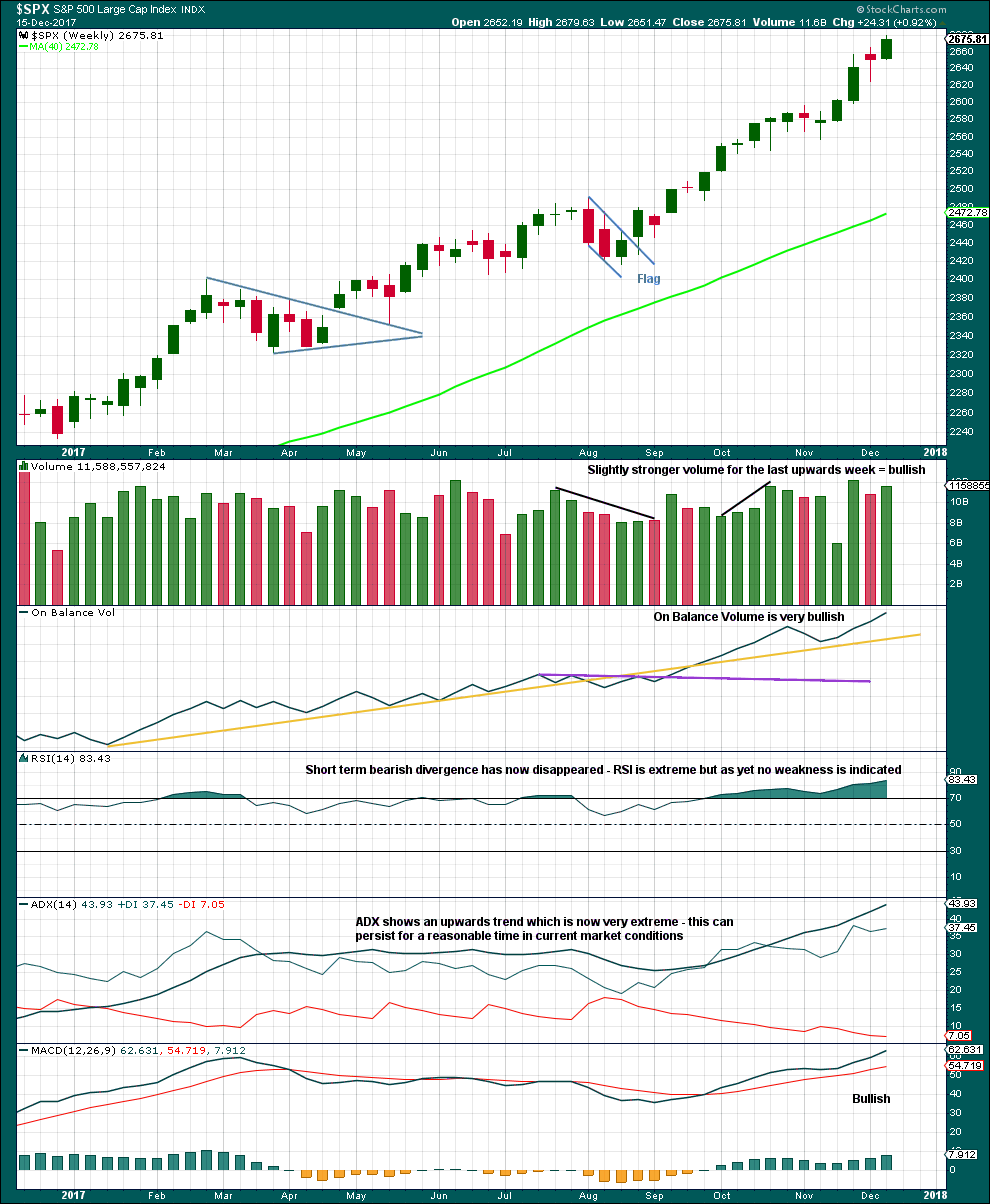
Click chart to enlarge. Chart courtesy of StockCharts.com.
There is still no candlestick reversal signal at highs. The trend is now very extreme and overstretched, but this can continue for longer before price is ready to turn.
Overall, at this time frame, this market remains very bullish.
DAILY CHART
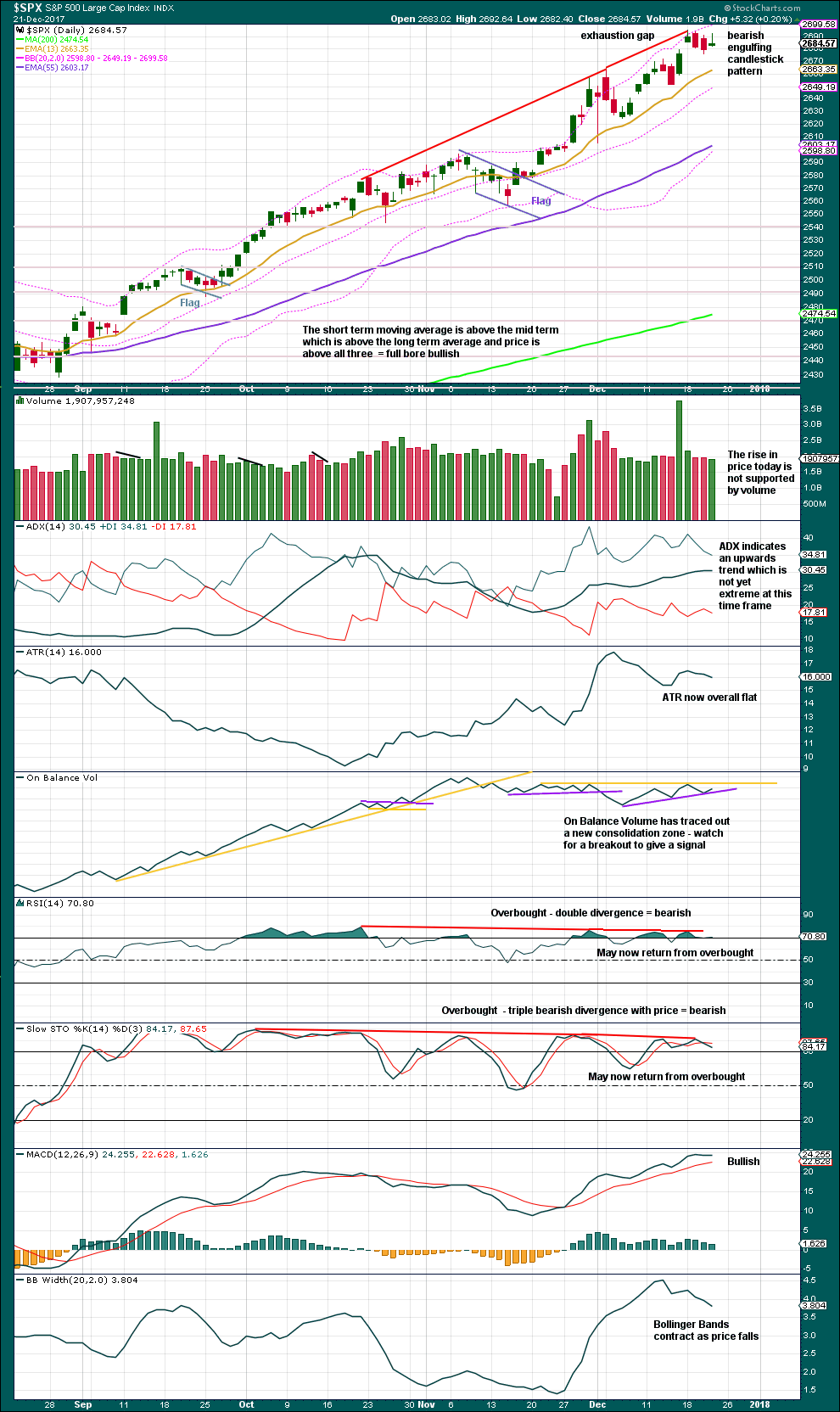
Click chart to enlarge. Chart courtesy of StockCharts.com.
The last gap is now closed. It is now indicated as an exhaustion gap and not a breakaway gap. This is a bearish signal, at least for the short term.
The last few signals from On Balance Volume were bearish. RSI and Stochastics are bearish. But ADX indicates the trend is not yet extreme at this time frame.
There are now two bearish candlestick patterns: a bearish engulfing pattern and now a gravestone doji. Along with the closed gap, this offers some support to the main wave count.
VOLATILITY – INVERTED VIX CHART
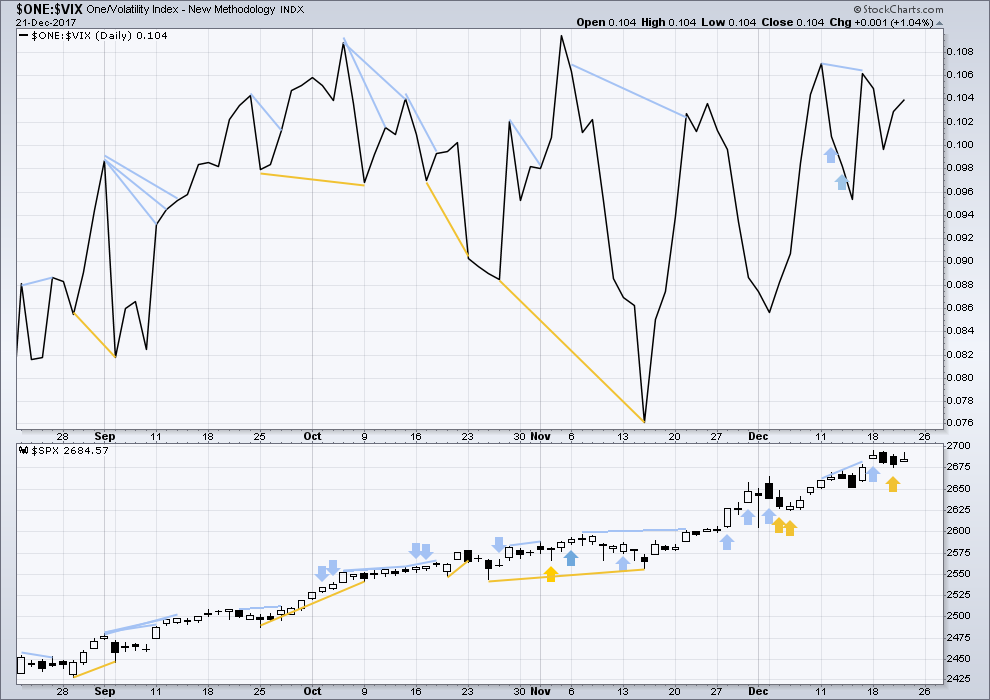
Click chart to enlarge. Chart courtesy of StockCharts.com.
So that colour blind members are included, bearish signals will be noted with blue and bullish signals with yellow.
Normally, volatility should decline as price moves higher and increase as price moves lower. This means that normally inverted VIX should move in the same direction as price.
A bullish divergence noted yesterday between price and VIX has now been followed by an upwards day. This may now be resolved, or it may need another upwards day to resolve it.
BREADTH – AD LINE
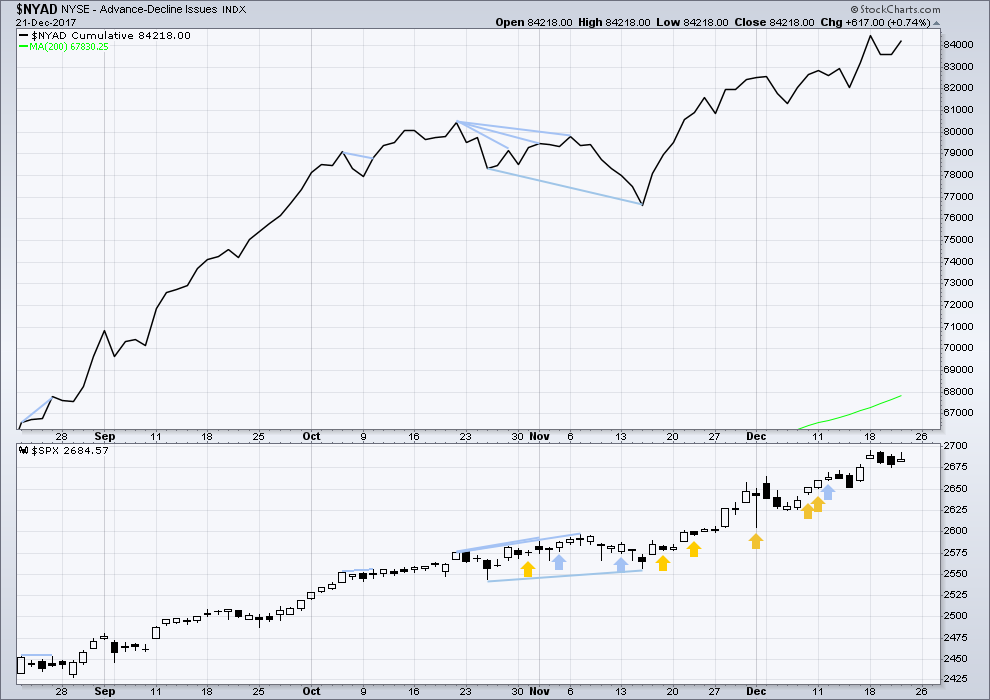
Click chart to enlarge. Chart courtesy of StockCharts.com.
There is normally 4-6 months divergence between price and market breadth prior to a full fledged bear market. This has been so for all major bear markets within the last 90 odd years. With no longer term divergence yet at this point, any decline in price should be expected to be a pullback within an ongoing bull market and not necessarily the start of a bear market.
Only large caps made new all time highs last week. There is some weakness with mid and small caps unable to make new all time highs; this is bearish.
Breadth should be read as a leading indicator. At this stage, there is no divergence between price and the AD line to indicate weakness.
DOW THEORY
The S&P500, DJIA and Nasdaq last week all made new all time highs. DJT now also made a new all time high, confirming the ongoing bull market.
The following lows need to be exceeded for Dow Theory to confirm the end of the bull market and a change to a bear market:
DJIA: 17,883.56.
DJT: 7,029.41.
S&P500: 2,083.79.
Nasdaq: 5,034.41.
Charts showing each prior major swing low used for Dow Theory are here.
Published @ 09:02 p.m. EST.
[Note: Analysis is public today for promotional purposes. Specific trading advice and comments will remain private for members only.]

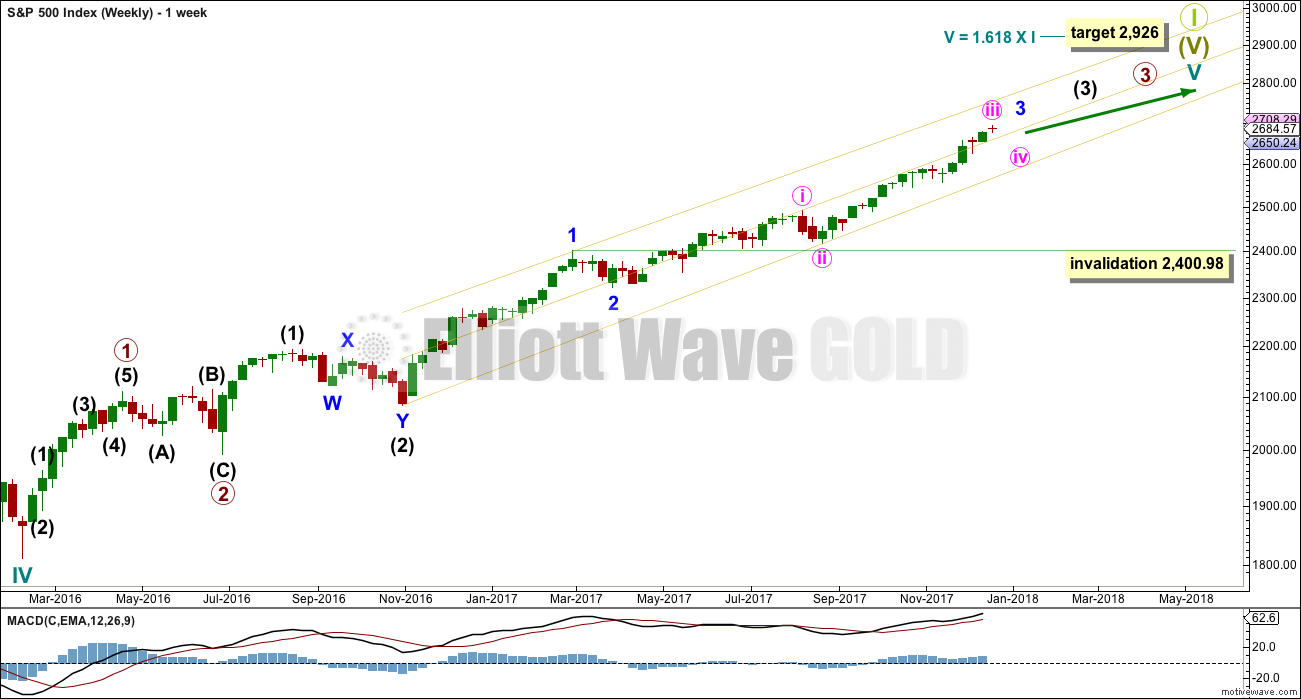
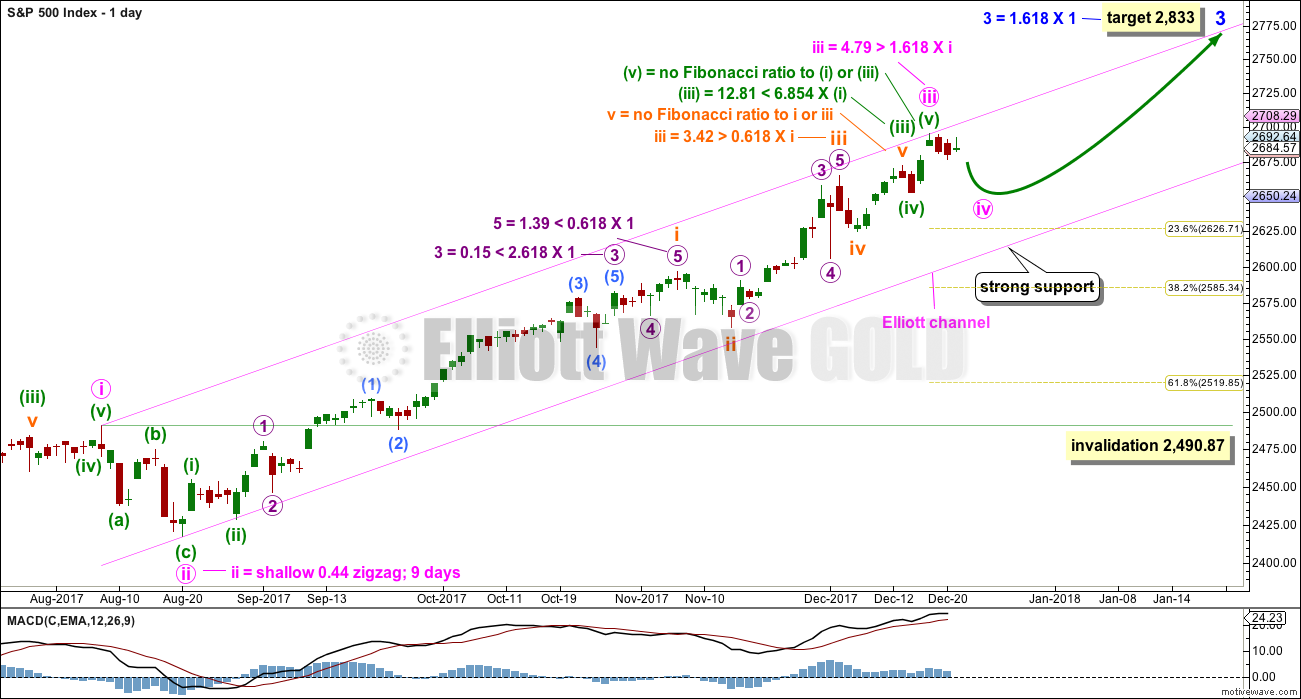
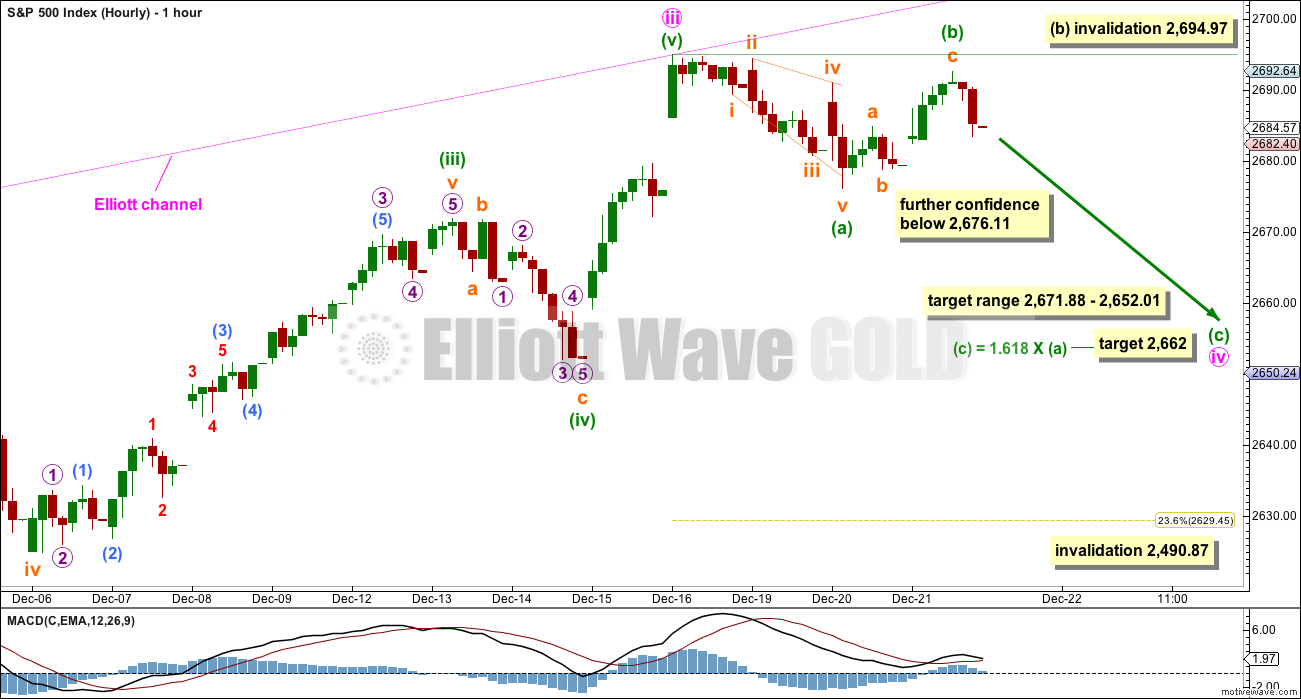
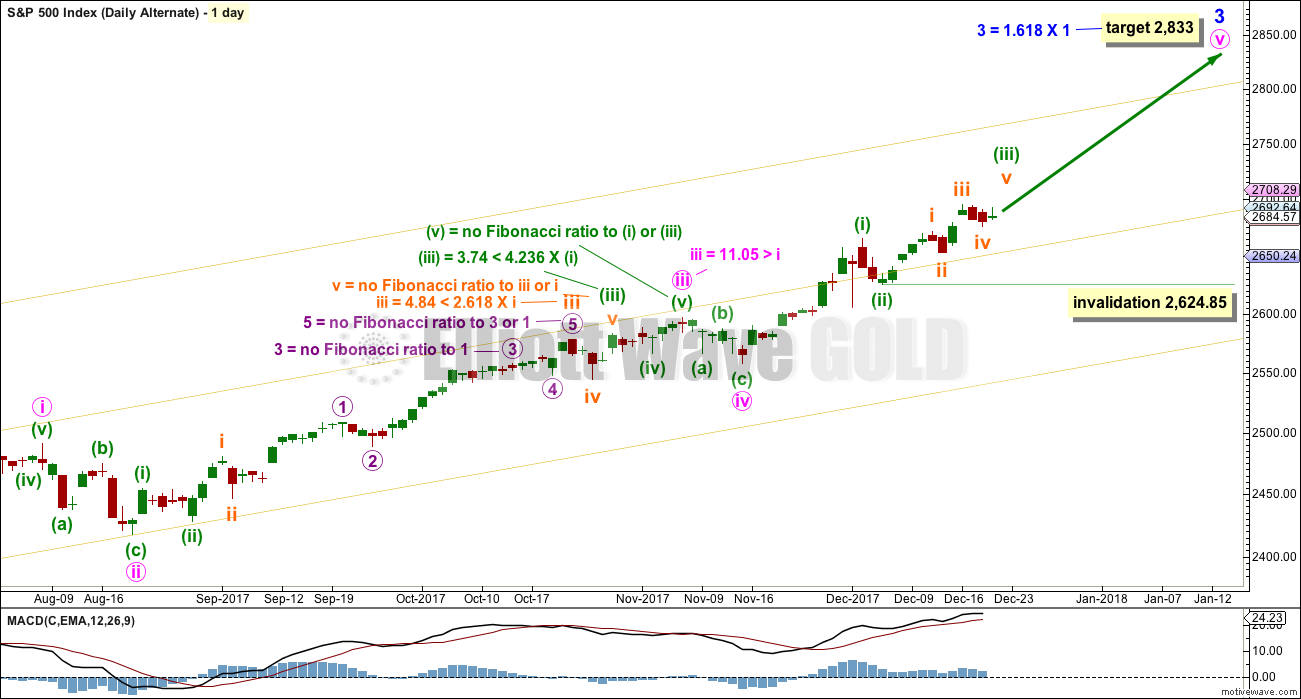

Im Sorry I meant 27135 in Dow Jones Industrial average go with your
S & P Wave 5 Circle 2933 – 2943 Target?
Hi Lara
Would the 25,549 in the Dow Jones Industrial average kind of go with your
Target Circle 3 of the 2833?
Does your target with the Circle 3 allow for 2781 – 2833 in S & P?
Also Would 28181 in the Dow Jones Industrial average kind of go with your
Target Circle 5 of 2926 – 2943?
The Elliot Wave Theorist posted these as possible Wave 5 top targets in the Dow Jones.
24899 – 28181
Thank you
My target 2,833 is for minor 3 (no circle, daily chart).
Yes, that could fit with a target about 25,549 for DJIA for a third wave there to end too.
Yes, minor 3 (daily chart, no circle) could end 2,781 to 2,833.
Yes, a higher target of 28,181 for DJIA could fit with a target of 2,926 – 2,943 for the S&P500.
It could all fit. And then it could all change in coming weeks.
“Likely end of throw-over per “Old Man” is in a 91 point range 24,808 to 24,899″
2017 is time analysis top call.
So right now as it has been in and out of that 4 trading days.
Right now both met. So we shall see if it confirms by going below LINE, the low of Thanksgiving week… 23,360.
We travelled down from our home in Northland on Thursday to Coromandel. Having a big family Christmas gathering down here.
This is Coromandel folks. Jaw dropping beautiful just everywhere. We found two pristine white sand beaches yesterday where we were the ONLY people there. Amazing. Love this place.
And one of the empty beaches yesterday. No surf though. Not yet.
Sweet pix, Lara! It’s sloppy here in Minneapolis, with deep cold forecast for Christmas day. A little warm NZ sun and sand looks mighty inviting right about now!
Thank you for all your careful labors in 2017. Hope you have a good time of rest with your family.
Thank you Curtis. We play on the beach here in NZ at Christmas. I’ve never had a white Christmas, although I did have a winter Christmas in San Francisco once. That was pretty weird 🙂
Just about to complete the S&P analysis and then champagne shall be opened 🙂
Nice place for a cozy hobbit hole for sure!
indeed! we hobbits do like to be cozy down here…
So far this is what I have for todays movement.
The rising 4 just penetrated the top of the 1 in that 5 wave down, I believe. The market appears more bullish than this now, at least short term.
Rather sleepy day, but the fireworks may be just around the corner. I will be getting short if/when the trend line shown gets cracked.
FWIW, SPX just bounced nicely off the up trend line that starts at the Dec 1 low. At the same time, INDU bounced off a 62% fibo. I’m long now…but won’t be if that trend line gets pierced.
Some reasonable “sale prices” on some equities. RH, CONE, and ALNY all look pretty fair to me.
Verne, I’m buying SVXY JAN 18 puts
Thanks for the offer yesterday Chris. However, I gave lots and lots of $$ to schools for 13 years and it was enough for me! Best of luck with the school.
Thank you Kevin, the school has made huge strides the last few years.
Chris, what school are you talking about? I did not see the beginning of this discussion.
Aspire Charter Academy, here in Orlando Fl
I went all the way to March next year with bearish 135/140 bearish call spreads.
Sold DIA 248 strike puts this morning for 0.80.
Moving to mostly cash for the time being with a small DIA 248 strike call position for next week. We entered this sideways move in an uptrend and will probably break from it to the upside. Have a great week-end and Merry Christmas everyone!
Nice, miners and energy are really breaking out. Had to take partial gain in NUGT today.
The Crooks out in force stealing shares through stop – sell orders in AG.
I bought more shares.
I bought more on 62% retrace of move. So I doubled # of shares I had.
Appears to be a “waiting day” for me. Market likely to muddle sideways/down, but not sufficiently to risk shorting. So it’s a game of if/when to start building some new long positions. Any insights into high quality set ups are welcome!
In other news…by bitcoin symbol GBTC is now at 1172, after achieving a high just a few days ago of 3525. Not surprising soon after futures trading opened, perhaps. Supply and demand equation for BOTH long and short positions probably changed dramatically with the arrival of that new market. The chart is dramatic, I must say. (weekly, daily, hourly, 5 minute, around the clock from the top left).
Okay I took the plunge!
I bought one (1) unit of GBTC for whopping $1374. I kindof expected a giant commission…nope! Only $1. Not too bad. So I am now officially a BITCOIN OWNER (well, a fraction of a coin owner). I feel so…modern!! Lol!!!!!! If I can sell it later today for a profit of more than $100, I will, honestly. But somehow I’m suspicious “it’ll all end in tears”.
That was quick! Took my profit, $100. What, about 7% gain in less than 10 minutes? Can’t argue with that. Time to shove in 50 grand???? Nope.
Wow… Bitcoin down almost 5,000 to 11,600
I won’t say anything about anything, I will just post this article on what the German experts are saying.
MORE WINNING: Germans Fear Huge Loss of Jobs from U.S. Tax Cuts
German economists are warning that the tax overhaul bill that now awaits the signature of President Donald Trump will mean that “significant amounts of new investment and jobs will shift from Europe to the United States,” according to the German business news publication Handelsblatt.
The United States has had a much higher tax rate for businesses than Germany and most of Europe. Under the tax reform bill, the corporate rate in the U.S. will fall to 21 percent, lower than the estimated 28.2 percent effective rate in Germany and close to the European average of 20.9 percent.
Handelsblatt reports:
“The tax competition will have a new dimension,” said Christoph Spengel, chairman of the corporate tax department at the University of Mannheim. Mr. Spengel, who is also a research associate at the Center for European Economic Research, and a group of tax experts at the university have done a detailed comparison of the two countries’ tax systems and published a report under the heading, “Germany loses out in US tax reform.”
Clemens Fuest, who heads the Ifo economic think tank, also said he believed German business would suffer. “Investments and jobs will migrate to the US,” he said.
The potential capital influx could be as high as $42.29 billion, or 39 billion euros, according to Handlesblatt.
Gavin Ekins, a research economist at the Tax Foundation in Washington, argued that it is not only the tax rate that will make the US more attractive. He told Handelsblatt Global that in figuring out their “service cost,” a metric that measures the cost of capital, companies also have to consider local labor costs, regulatory burdens, and things like energy prices and the cost of land.The US has the advantage in almost every category, he noted, but until now firms were deterred by the high corporate tax.
“Now you get a windfall for having capital in the US, so that causes investors to invest,” Mr. Ekins says. The change in the capital investment rules gives US firms “a tremendous advantage,” he said. “It’s a pro-capital formation tax bill and this is why other countries are so wary about what the investment landscape will look like.”
Using direct investment figures from the period 2008-2012, the German specialists calculated that the value of German foreign direct investment in the US could rise by €39 billion with the tax reform. It said US direct investment in Germany would also rise, but by a much smaller amount: €6.3 billion.
Handlesblatt’s reporting highlights the shallowness of much of the U.S. media’s coverage of the tax bill, which has focused on claims that U.S. corporations are likely to use much of the windfall from tax cuts to pay dividends and buy back shares.
So awesome Joe!!!!!!
Breitbart News…
First again!
You win!